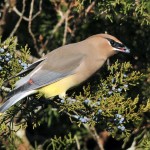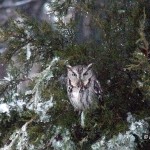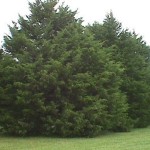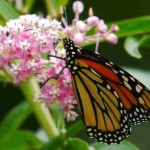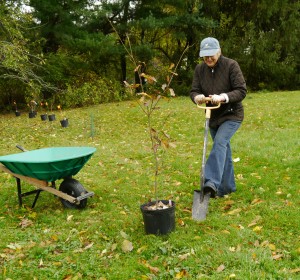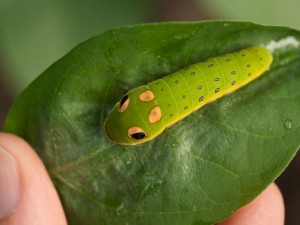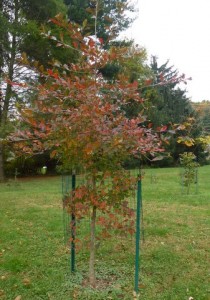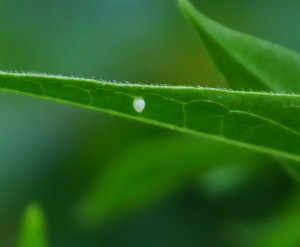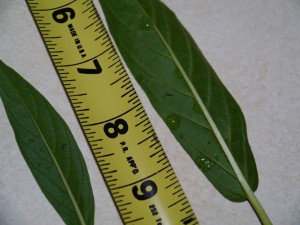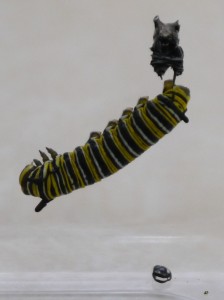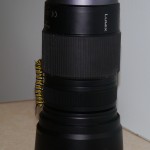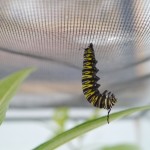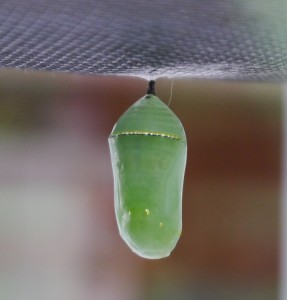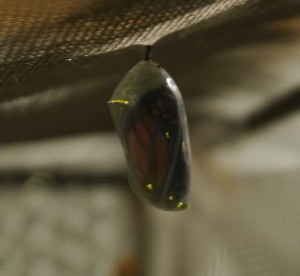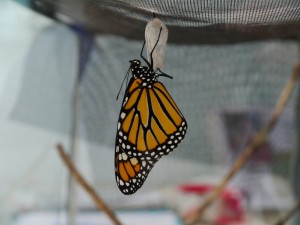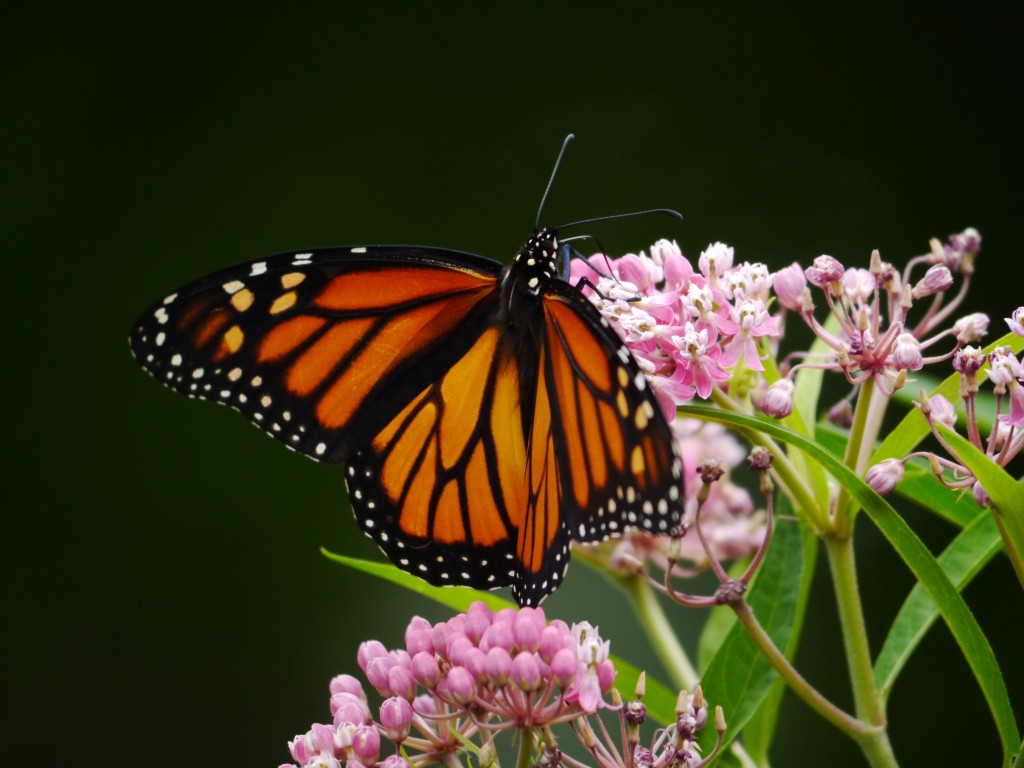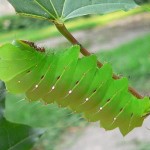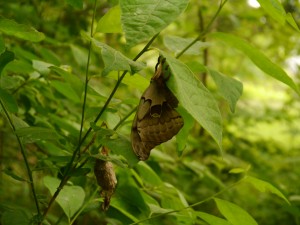By Barb Elliot
Wildlife is abundant in Edie’s yard. She finds birds, butterflies, moths, dragonflies, bugs,
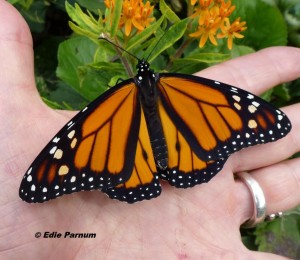
Monarch newly emerged and ready for release. Raised from eggs laid on Edie’s Butterfly Milkweed. © Edie Parnum. Click to enlarge.
beetles, bees, wasps, flies, and more – creatures she loves – living among her native plants.
It wasn’t always this way. I saw the yard when Edie moved to this ¾-acre property in 2007. It was mostly turf grass. Except for a few native trees (Black Cherry, Red Maple, White Pine), no native plants grew here. Consequently, we observed few birds—just an occasional robin or starling—no other wildlife. She knew she could transform her lifeless property into a healthy habitat for wildlife by reducing the lawn and planting native plants. It could become a place where she could discover, learn, and enjoy nature.
To create a healthy ecosystem on her property she wanted to:
- Plant a diversity and multitude of native plants
- Offer conditions for birds and other creatures to thrive and reproduce
- Provide year-round food sources, water, cover, and places to raise young for wildlife
- Welcome lots of birds—certainly hummingbirds
- Create a place of beauty where she could be immersed in nature
- Learn the species of flora and fauna and how they interact and depend on each other
- Leave a legacy of nature for future generations with long-lived trees and shrubs
Gradually, year by year, she has succeeded in creating this haven for wildlife. Eight years later I see thousands of native plants. They include perennials, grasses, vines, ferns, and woody plants, i.e. shrubs and trees. She planted densely, letting the plants touch each other as they do in the wild. Her canopy trees are young, but the oaks and others will be massively productive for wildlife for decades. Eastern Redbud, Flowering Dogwood, and Shadbush are already filling the understory. The mature shrubs like Spicebush, Elderberry, and several viburnum species are now luxuriant. At the ground
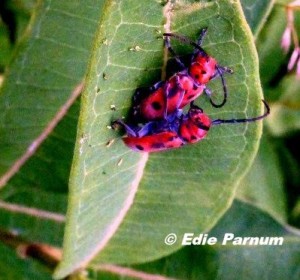
Red Milkweed Beetles eat plants in the milkweed family. The beetles are protected by the milkweed’s toxins and the black and red colors. © Edie Parnum. click to enlarge.
level perennials, vines, ferns, sedges, and grasses, are profuse. This diversity of plants offer nuts, seeds, berries, nectar, and pollen. Even the foliage of the native plants is indirectly a source of food. Insects eat the leaves and become food for birds and other creatures.
Birds now find what they need to live and thrive. They eat the fruits, nuts, seeds, and nectar produced by the yard’s native plants. Resident and migrating birds eat the insects hosted by her native plants. For example, Carolina
Chickadees can locate the 6, 000-plus caterpillars required to feed their young. Of course, no pesticides are ever used.
Edie has added other features for birds. She installed nest boxes for cavity-nesting House Wrens and Tree Swallows. She allows fallen leaves to lie in many places. Eastern Towhees and Brown Thrashers rummage in this leaf litter to find insects. Carolina Wrens
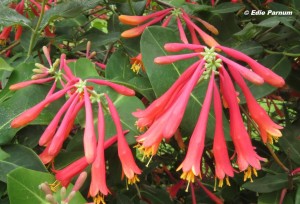
Trumpet Honeysuckle, a well-behaved vine with hummingbird-attracting red tubular flowers. © Edie Parnum. Click to enlarge.
often locate their insect delicacies in the brush pile. On a snag (dead tree) woodpeckers, including a Pileated Woodpecker, forage for insects in the decaying wood. A Trumpet Vine grows on this snag and attracts hummingbirds seeking nectar from its flowers. A bird bath and small pond offer birds water. The bird feeders supply a small proportion of food needed by some of the birds. Many, many birds (106 species) love this yard.
Her meadow, in my opinion, is the crown jewel of her property. It is chock full of colorful perennials and grasses. Birds forage for seeds in late summer, fall, and winter. Numerous butterflies (30 species so far), bees, beetles, and other pollinators are active on flowers
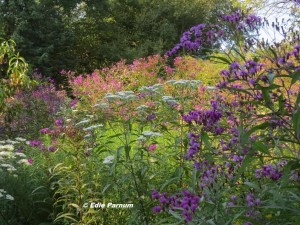
Edie’s Meadow in late summer. Flowers attract butterflies, moths, and other insect pollinators. © Edie Parnum. Click to enlarge.
blooming from April through October. Even at night the meadow is alive with moths, beetles, and other insects and spiders. Aiming a flashlight into the dense meadow plants, she can see the tiny, shining eyes of moths and other insects. Bumble bees, too, sleep on the flower heads, resting for the next day’s work.
Edie has created a paradise for herself as well as the creatures that call her yard home. With binoculars and camera, she frequently takes nature walks around the yard. The birds, whether eating, preening, feeding young, are always interesting. Mating foxes are less expected. Mating Garter Snakes, too. Even
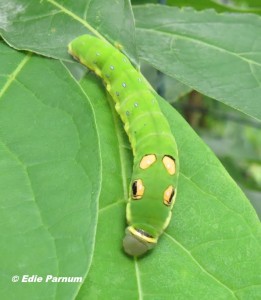
Spicebush Swallowtail caterpillar on Sassafras, one of its host plants.© Edie Parnum. Click to enlarge.
better, she loves to discover a caterpillar eating leaves. When she locates other tiny creatures—bees, beetles, wasps, and others—she takes their photos. At night she uses lights to attract moths. She photographs these creatures, too.
Using the photos of insects, she can usually make identifications and then figure out their role in this ecosystem. What plants do they depend on? What plants depend on them? What do they eat? Who eats them? Are they parasites? Predators?
The possibilities for discovery are endless. Mostly, she revels in success of the healthy ecosystem she has created.
——————————————————————————-
Nature Discovery Day, August 29, 2015
Edie enjoys showing her garden with its native plants, birds, butterflies, moths and other creatures to nature-loving friends. On August 29th she will host Nature Discovery Day. Throughout the day you can explore her yard, discover nature in action, and learn about habitat gardening. Guided walks for children and adults will be offered, too. In the evening it’ll be Moth Night.
This event will be for a limited audience by invitation only. She’s inviting Backyards for Nature blog readers and their interested family and friends. Save the date and watch for an invitation coming to you in late July or early August.

